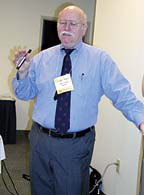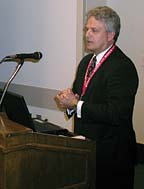
That remains true today.
As BACnet is increasingly being deployed around the world, its capabilities with building automation and controls are also expanding through the continuous maintenance of the standard (ANSI/ASHRAE Standard 135, "BACnet - A Data Communication Protocol for Building Automation and Control Networks").
At the Anaheim Convention Center, three prominent people involved in BACnet's creation described new advances with the standard. At the same time, those manufacturers affiliated with BACnet showed off their newest wares at the International Air-Conditioning, Heating, Refrigerating Exposition (AHR Expo).
Of course, where there is BACnet, there is LonMark International. Several members expounded on the virtues of the organization and the interoperable products each member makes, which were also showcased on the expo floor.
At this year's show, however, both BACnet and LonMark had to share the limelight with a new kid on the building automation system (BAS) block. The Continental Automated Buildings Association (CABA) and Clasma Inc. co-sponsored the first-ever XML (eXtensible Markup Language) Symposium, a day-long, high-level introduction to what it called "the most important enabling technology for the future of integrated and intelligent buildings with a specific focus on the HVAC industry." (See related story, "Symposium Works To Spell Out XML's Role," in this issue.)
BACnet Update
In addition to Newman, who is now chair of the BACnet XML Working Group, other speakers included Steve Bushby, current chair of ANSI/ASHRAE Standard 135 (SSPC) committee, and Jim Lee, president of the BACnet Manufacturers Association."A lot has happened since the original version of the BACnet standard was published in the summer of 1995," said Bushby. "A lot has happened since then both in terms of new capabilities being added to the standard and in the realization of those features in BACnet products installed around the world."
Newman noted that some more changes are coming in the near future related to the use of XML and Web services technology.
"BACnet's chore is its ‘objects' and ‘services' model," stated Newman. "The objects allow the functionality of building automation and control system de-vices to be unambiguously represented. The services allow communication between devices related to their functionality. In addition, BACnet prescribes a variety of wide- and local-area internetworking solutions."
Newman said BACnet's biggest strength is its ability to evolve and embrace new technologies as they become available, "thus enabling it to meet the ever-growing needs and expectations of building owners, operators, and users."
An example of this development, said Newman, was the creation of BACnet/IP several years ago. This enabled BACnet messages to be sent over the Internet.
"Today our industry is abuzz with the possibility of integrating building automation and business systems in such a way as to create valuable new services for the building owner," said Newman. "In an attempt to find a common language between systems, SSPC 135 is deliberating the addition of the information technology (IT) known as Web services to the BACnet standard.
"Web services is a set of technologies that enable machine-to-machine communications, using two standards called XML and SOAP [Simple Object Access Protocol]."
According to Newman, the design objectives for this new capability include:
"The use of XML to represent BACnet messages will permit ‘Web services' gateways to provide building automation data to ‘enterprise' systems in a new way," said Newman. "At the ASHRAE 2004 Winter Meeting, a small group was formed within the XML-WG to develop a Web service that will use a hierarchical naming method to identify building information that can then be used in business applications, reports, and spreadsheets.
"The service will also allow searching for, and modification of, building data by appropriately authorized users. The service will be structured in such a way as to permit its application to other building automation protocols that may be present."
He admitted that BACnet and other protocols, such as LonMark and CABA/oBIX (see related story, "Symposium Works To Spell Out XML's Role," in this issue), are not formally working together, "but many of the participants in the oBIX work are on the respective BACnet or LonMark committees.
"The oBIX agenda seems to be in a state of flux, so it is not yet possible to determine potential conflicts," said Newman.
Bushby said that since SSPC 135 was created, it has deliberated, approved, and put through about 130 proposed additions to the standard through the public review process. "These ideas were combined into six addenda that have already been published and three more that will be approved for publication this week," he said.

LonMark States Its Case
Since its inception in 1994 and new corporate structure in 2003, LonMark International has "become a major driving force in the establishment of interoperable guidelines for building, industrial, transportation, and residential/utility automation," said Barry Haaser, the organization's executive director. "It is a global membership organization created to promote and advance the business of efficient and effective integration of open, multi-vendor control systems."At the LonMark press conference, Haaser noted that its membership is open to any manufacturer, end user, and system integrator committed to the development and use of open, interoperable products using ANSI/EIA 709 and related standards. There are more than 300 members worldwide. The organization is now looking to put together affiliate networks around the world.
"Demand for open systems based on LonWorks technology is stronger than ever before as is evident with the availability of over 500 LonMark-certified products," said Haaser. "It is evident just by the sheer numbers that open interoperable systems using LonMark-certified products have become the industry norm. Clearly, having the LonMark brand on products creates meaningful sales for LonMark members, because end users are demanding completely open, end-to-end solutions."
With new chief marketing officer Ken Toren now in the fold, Haaser said the association will market itself more as a solutions-based organization, "rather than as a technical organization."
The executive director announced that the New York City School Construction Authority (SCA), in charge of construction projects for the New York City School District, and its engineering consultant, Burns & Roe Enterprises Inc. of Oradell, N.J., have specified a LonWorks open system control architecture as the design standard for new school construction projects. The control architecture employs LonMark control field devices and the Echelon LNS operating system for new school construction within the district.
"By choosing LonMark products, the schools will have the flexibility, cost-savings, and freedom of choice that is limited by a closed system," said Haaser.
Other LonMark organization members that made presentations included Echelon, Circon, Distech, Engenuity, PureChoice, T.A.C., and Trane. Each unveiled BAS-related products at the expo.
For a full report on the building automation and controls products introduced at the 2004 AHR Expo, see the feature story "More New Products Designed To Make Buildings Smarter" in this issue.
Publication date: 02/23/2004

Report Abusive Comment